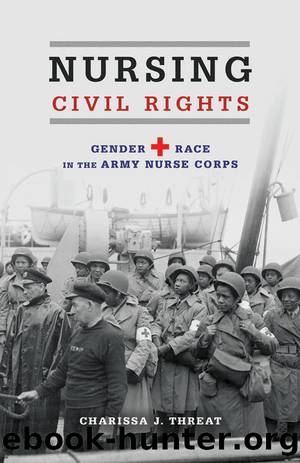Nursing Civil Rights: Gender and Race in the Army Nurse Corps by Charissa J. Threat

Author:Charissa J. Threat [Threat, Charissa J.]
Language: eng
Format: epub
Tags: Medical, United States, Military, Civil Rights, Political Science, History, General, Nursing
ISBN: 9780252097249
Google: URuABwAAQBAJ
Goodreads: 54216372
Publisher: University of Illinois Press
Published: 2015-04-15T11:44:11+00:00
Korea: Testing Race Desegregation/Debating Gender Roles
While the debate over male nurse inclusion continued within the ranks of the military and among male nurse supporters, pressing hostilities in Korea highlighted a new phase in the Cold War. The involvement of the United States and Soviet Union in a larger conflict led to the escalation and expansion of what was internally a civil war in Korea. Officially known as a âpolice action,â or the Korean War in the United States, the U.S. military found itself fighting a war that was not ever a declared war.85 The ANC provided care in an environmentâboth stateside and abroadâunlike any other in its fifty-year history. Estimates vary on the number of ANC nurses who served in Korea over the course of the conflict, but nurse corps numbers during this period fluctuated between thirty-five hundred and five thousand.86 The army had nurses stationed across the United States, Europe, and areas in East Asia, including Japan and Korea in the first few years of the 1950s.
Hostilities in Korea began on June 25, 1950; in less than two weeks the first twelve Army nurses arrived in Pusan to form the 8055th Mobile Army Surgical Hospital (MASH).87 MASH units were the medical units closest to the front that employed army nurses. Throughout the three-year hostilities, army nurses became renowned for their hard work, courage, and devotion to duty, with praise from surgeons and soldiers. This dedication and the Medical Departmentâs advances in combat medicine translated to an astonishing survival rate. The death rate for soldiers admitted to hospitals was reduced from forty for every one thousand patients admitted during World War II to under ten men per one thousand admitted to army hospitals during the Korean War.88 These accomplishments did not make the ANC or its members immune, however, to social struggles in the United States. This was the militaryâs first opportunity to test the grand experiment of an desegregated Army. It was also an opportunity to test and continue the debate about gender roles in the ANC as both nursing shortages generally, and combat conditions specifically, pushed many to reassess the nurse corpsâ insistence on a single-sexed organization.89
Civil rights activists paid particular attention to the activities of African Americans serving with the armed forces following the passage of Executive Order 9981. The Korean War and the militaryâs activities in other overseas regions provided the perfect opportunities to observe the effectiveness of integration. As they had done during World War II, the black press played the role of watchdog and cheerleader, celebrating the activities of black soldiersâmen and womenâwho served overseas, and reporting any violations of the presidentâs order. Littered throughout the pages of the Chicago Defender, Pittsburgh Courier, and Baltimore Afro-American were reports of equal rights successes and failures that revealed contradictions to the integration of the armed forces. Four years after the passage of E.O. 9981, for example, the Chicago Defender praised the reversal of the navyâs exclusion of African American women the year before the Korean War began.
Download
This site does not store any files on its server. We only index and link to content provided by other sites. Please contact the content providers to delete copyright contents if any and email us, we'll remove relevant links or contents immediately.
| Automotive | Engineering |
| Transportation |
Urban Outlaw by Magnus Walker(2946)
Never by Ken Follett(2872)
OPNsense Beginner to Professional by Julio Cesar Bueno de Camargo(2779)
Sapiens and Homo Deus by Yuval Noah Harari(2405)
Machine Learning at Scale with H2O by Gregory Keys | David Whiting(2264)
A Short History of Nearly Everything by Bryson Bill(2131)
Will by Will Smith(2032)
Hooked: A Dark, Contemporary Romance (Never After Series) by Emily McIntire(1932)
Borders by unknow(1779)
Rationality by Steven Pinker(1760)
Holy Bible (NIV) by Zondervan(1711)
Freedom by Sonny Barger(1484)
The One Percenter Encyclopedia by Bill Hayes(1460)
Five Ways to Fall by K.A. Tucker(1394)
Girls Auto Clinic Glove Box Guide by Patrice Banks(1356)
Far and Near by Neil Peart(1352)
The Becoming by Nora Roberts(1323)
Cuba's Car Culture by Tom Cotter(1321)
A Short History of War by Jeremy Black(1295)
